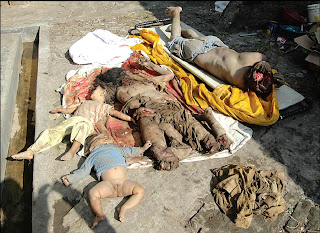It is a war that is no longer subject to just scorching summers and consequently disappearing water-holes. At Hajongbari village, less than 10 kms from Guwahati, a human-elephant had just happened a day back – killing two locals at the nearby Amsing reserve forest that is now being demarcated a sanctuary. “They were killed because in the narrow jungle track the animal has nowhere to turn,” says Dilip Daimari, who will now have to leave his ancestral home in the jungle, to make way for a safe home for elephants.
At Hajongbari village, less than 10 kms from Guwahati, a human-elephant had just happened a day back – killing two locals at the nearby Amsing reserve forest that is now being demarcated a sanctuary. “They were killed because in the narrow jungle track the animal has nowhere to turn,” says Dilip Daimari, who will now have to leave his ancestral home in the jungle, to make way for a safe home for elephants.
“Earlier, we could chase them away quite easily but with time they now stand their ground and oft en attack,” says Anil, a farmer, who has seen others’ crops destroyed by the animals. The future is ominous: there are less than 10 groups of Asiatic elephants with member count of 1,000 or more in a contiguous area, cutting down on the animal’s chances of survival in the long run, reports of an increase in population notwithstanding.
 At Hajongbari village, less than 10 kms from Guwahati, a human-elephant had just happened a day back – killing two locals at the nearby Amsing reserve forest that is now being demarcated a sanctuary. “They were killed because in the narrow jungle track the animal has nowhere to turn,” says Dilip Daimari, who will now have to leave his ancestral home in the jungle, to make way for a safe home for elephants.
At Hajongbari village, less than 10 kms from Guwahati, a human-elephant had just happened a day back – killing two locals at the nearby Amsing reserve forest that is now being demarcated a sanctuary. “They were killed because in the narrow jungle track the animal has nowhere to turn,” says Dilip Daimari, who will now have to leave his ancestral home in the jungle, to make way for a safe home for elephants.“Earlier, we could chase them away quite easily but with time they now stand their ground and oft en attack,” says Anil, a farmer, who has seen others’ crops destroyed by the animals. The future is ominous: there are less than 10 groups of Asiatic elephants with member count of 1,000 or more in a contiguous area, cutting down on the animal’s chances of survival in the long run, reports of an increase in population notwithstanding.
If statistics could save species, the scariest would be the one that says tropical forests that contain more than half the world’s wild species, lose 17 million hectares a year. Amsing is only one among tens of others on the planet where the elephant now stands threatened.
For Complete IIPM Article, Click on IIPM Article
Source: IIPM Editorial, 2007
An IIPM and Management Guru Prof. Arindam Chaudhuri's Initiative
Source: IIPM Editorial, 2007
An IIPM and Management Guru Prof. Arindam Chaudhuri's Initiative
Home Campus Tour Contact Us Sitemap IIPM Think Tank IIPM National Brochure IIPM in Media India Today & Tomorrow
Strategic Alliance / Consulting / Intellectual Tic-up Partners Arindam chaudhuri GIDF Planman Consulting Business & Economy 4Ps Business & Marketing The Sunday Indian The Daily Indian Kkoooljobs.com